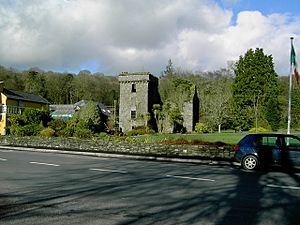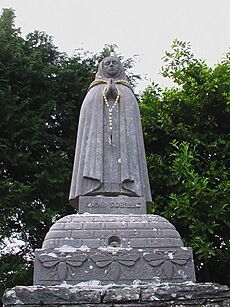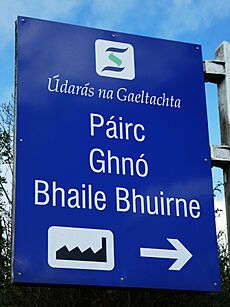Ballyvourney facts for kids
Quick facts for kids
Ballyvourney
Baile Bhuirne
|
|
|---|---|
|
Village
|
|

Ruin of former Colthurst residence, The Mills Inn, Ballyvourney
|
|
| Country | Ireland |
| Province | Munster |
| County | County Cork |
| Irish Grid Reference | W195770 |
| Baile Bhúirne is the only official name as it is situated in a Gaeltacht (Irish-speaking area). | |
Ballyvourney (called Baile Bhuirne in Irish) is a lovely village in southwest County Cork, Ireland. Its name means 'Town of the Beloved'. It is a special place because it is a Gaeltacht area. This means Irish is the main language spoken here.
Ballyvourney is also a civil parish and an ecclesiastical parish. It is part of the Cork North-West Dáil Constituency.
Contents
Getting to Ballyvourney
The village is located along the N22 road. This road connects Cork city, which is about 48 km away, with Killarney. The closest big town is Macroom, about 14 km away. The nearest international airport is Cork Airport.
There are plans to build a new dual carriageway. This road will bypass Macroom and finish west of Ballyvourney. You can also get to Ballyvourney by bus. The Bus Éireann Expressway Route 40 goes through the village. This route connects Rosslare Europort and Tralee.
Ballyvourney's Past
Long ago, the people of Múscraige lived here. They were once ruled by the Corcu Loígde. Later, they changed their loyalty to the Eóganachta. This helped the Eóganachta become powerful kings of Munster.
During the Irish War of Independence, an important event happened here. On July 18, 1921, the IRA attacked a British supply truck. This happened just south of Ballyvourney. Two British soldiers died in this ambush.
Culture and Fun in Ballyvourney
Speaking Irish in Ballyvourney
Ballyvourney is part of the Muskerry Gaeltacht. This is an area where the Irish language is officially spoken. Many people in the area know Irish very well. However, English has been the main language in homes since the 1920s.
In 2016, about 21% of people in the local area spoke Irish daily. This was outside of school. The Gaeltacht status brings many visitors to the village. People also come to see its old buildings and history.
Saint Gobnait and Local Traditions
The village is strongly linked to Saint Gobnait. You can visit her old abbey, cells, and St Gobnait's well here. Her special day, called Pattern Day, is on February 11. The community still celebrates this day. During a Mass at the well, everyone takes water from it.
Legend says Gobnait was born in County Clare in the 6th century. She ran away from Clare and went to the Aran Islands. There, an angel told her to go on a journey. The angel said she would find her home when she saw nine white deer. She traveled south and found three white deer in Clondrohid. She followed them to Killeens, Ballymakeera, where she saw six more. Finally, she found all nine white deer in Baile Bhuirne. She stayed there and started a convent. The remains of her convent are still a place where people go on pilgrimages.
The abbey also has an old stone carving. There are also stone circles and other ancient sites nearby.
Music and Dance in the Village
The famous composer Seán Ó Riada is buried in the local cemetery. The traditional Irish singer Elizabeth Cronin lived her whole life in this area.
Ballyvourney also gives its name to an Irish dance. It's called the Baile Bhuirne Set. The village is home to Ionad Cultúrtha. This is a cultural center for traditional and modern arts. It hosts many music and art events.
Places to Visit and Enjoy
St. Gobnet's Wood is an old woodland. It covers about 30 hectares and has many old Sessile Oak trees. The local primary school is called Scoil Aban Naofa. It is named after Saint Aban, who is connected to the area.
The secondary school is Coláiste Ghobnatan. It was formed in 1989 when two older schools joined together. The school is named after Saint Gobnait. The principal says they place all their work under her protection.
The old Coláiste Iosagáin college grounds were used for filming. The movie Song for a Raggy Boy was filmed there. The film The Wind That Shakes the Barley was also filmed in nearby places.
You can find several bars and restaurants in the village. These include "The Mills Inn" and "The Abbey Hotel." There's also "The Hibernian," "The Crúiscín Lán," and "The Village Takeaway & Diner." The Mills Inn is built where an old police station used to be.
Ballyvourney also hosts several cultural events:
- Patron Saint's Day (Lá Pátrúin) on February 11.
- Whit Sunday feast day.
- Ballyvourney - Coolea Annual Show (Taispeántas Bhaile Bhúirne).
- Cultural & Heritage Centre (Ionad Cultúrtha Baile Bhúirne). This center also offers educational programs and traditional music concerts.
- Irish language courses are organized by Gael-Linn. These take place at the Irish College (Coláiste Bhaile Bhúirne).
Jobs and Businesses
Ballyvourney offers many job chances. These include jobs in farming, industry, and hospitality. Údarás na Gaeltachta helps businesses by providing grants. Many of these businesses are located in Ballyvourney's industrial area.
Sports in Ballyvourney
The main Gaelic football club is Naomh Abán GAA. They have won many championship titles. Anthony Lynch is from Ballyvourney. He plays for the local team and also for the Cork senior football team.
The local soccer club is Sullane F.C. They have teams in the West Cork league. These include both senior and younger age groups.
Famous People from Ballyvourney





